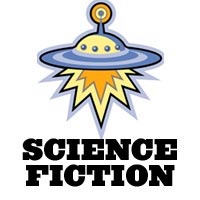 Science Fiction Films are
usually scientific, visionary, comic-strip-like, and imaginative, and usually
visualized through fanciful, imaginative settings, expert film production
design, advanced technology gadgets (i.e., robots and spaceships), scientific
developments, or by fantastic special effects. Sci-fi films are complete with
heroes, distant planets, impossible quests, improbable settings, fantastic
places, great dark and shadowy villains, futuristic technology and gizmos,
and unknown and inexplicable forces. Many other SF films feature time travels
or fantastic journeys, and are set either on Earth, into outer space, or (most
often) into the future time. Quite a few examples of science-fiction cinema
owe their origins to writers Jules Verne and H.G. Wells. Science Fiction Films are
usually scientific, visionary, comic-strip-like, and imaginative, and usually
visualized through fanciful, imaginative settings, expert film production
design, advanced technology gadgets (i.e., robots and spaceships), scientific
developments, or by fantastic special effects. Sci-fi films are complete with
heroes, distant planets, impossible quests, improbable settings, fantastic
places, great dark and shadowy villains, futuristic technology and gizmos,
and unknown and inexplicable forces. Many other SF films feature time travels
or fantastic journeys, and are set either on Earth, into outer space, or (most
often) into the future time. Quite a few examples of science-fiction cinema
owe their origins to writers Jules Verne and H.G. Wells.
See also AFI's 10
Top 10 - The Top 10 Science Fiction Films
They often portray the dangerous and sinister nature of knowledge
('there are some things Man is not meant to know') (i.e., the classic Frankenstein
(1931), The Island of Lost Souls (1933), and David Cronenberg's The Fly (1986) - an updating of the 1958 version directed by Kurt Neumann
and starring Vincent Price), and vital issues about the nature of mankind
and our place in the whole scheme of things, including the threatening, existential
loss of personal individuality (i.e., Invasion of the
Body Snatchers (1956), and The Incredible Shrinking Man (1957)).
Plots of space-related conspiracies (Capricorn One (1977)), supercomputers
threatening impregnation (Demon Seed (1977)), the results of germ-warfare
(The Omega Man (1971)) and laboratory-bred viruses or plagues (28
Days Later (2002)), black-hole exploration (Event Horizon (1997)),
and futuristic genetic engineering and cloning (Gattaca (1997) and
Michael Bay's The Island (2005)) show the tremendous range that science-fiction
can delve into.
Strange and extraordinary microscopic organisms or giant,
mutant monsters ('things or creatures from space') may be unleashed, either
created by misguided mad scientists or by nuclear havoc (i.e., The Beast
From 20,000 Fathoms (1953)). Sci-fi tales have a prophetic nature (they
often attempt to figure out or depict the future) and are often set in a speculative
future time. They may provide a grim outlook, portraying a dystopic view of
the world that appears grim, decayed and un-nerving (i.e., Metropolis (1927) with its underground slave population and view of the effects of industrialization,
the portrayal of 'Big Brother' society in 1984 (1956 and 1984), nuclear annihilation in a post-apocalyptic world in On the Beach
(1959), Douglas Trumbull's vision of eco-disaster in Silent Running
(1972), Michael Crichton's Westworld (1973) with androids malfunctioning, Soylent Green (1973) with its famous quote: "Soylent Green IS
PEOPLE!", 'perfect' suburbanite wives in The Stepford Wives (1975), and the popular gladiatorial sport of the year 2018 in Rollerball (1975)).
Commonly, sci-fi films express society's anxiety about technology and how
to forecast and control the impact of technological and environmental change
on contemporary society.
A special subsection has been created on the subject of robots in film.
See:  Robots in Film (a comprehensive illustrated history here). Robots in Film (a comprehensive illustrated history here).
Science fiction often expresses the potential of technology
to destroy humankind through Armaggedon-like events, wars between worlds,
Earth-imperiling encounters or disasters (i.e., The Day The Earth Stood Still (1951), When Worlds Collide
(1951), The War of the Worlds (1953), the two Hollywood blockbusters Deep Impact (1998) and Armageddon (1998), and The Day After
Tomorrow (2004), etc.). In many science-fiction tales, aliens, creatures,
or beings (sometimes from our deep subconscious, sometimes in space or in
other dimensions) are unearthed and take the mythical fight to new metaphoric
dimensions or planes, depicting an eternal struggle or battle (good vs. evil)
that is played out by recognizable archetypes and warriors (i.e., Forbidden
Planet (1956) with references to the 'id monster' from Shakespeare's The
Tempest, the space opera  Star Wars (1977) with knights and a princess
with her galaxy's kingdom to save, The Fifth Element (1997), and the
metaphysical Solaris (1972 and 2002)). Beginning in the 80s,
science fiction began to be feverishly populated by noirish, cyberpunk films,
with characters including cyber-warriors, hackers, virtual reality dreamers
and druggies, and underworld low-lifers in nightmarish, un-real worlds (i.e., Star Wars (1977) with knights and a princess
with her galaxy's kingdom to save, The Fifth Element (1997), and the
metaphysical Solaris (1972 and 2002)). Beginning in the 80s,
science fiction began to be feverishly populated by noirish, cyberpunk films,
with characters including cyber-warriors, hackers, virtual reality dreamers
and druggies, and underworld low-lifers in nightmarish, un-real worlds (i.e.,  Blade
Runner (1982), Strange Days (1995), Johnny Mnemonic (1995),
and The Matrix (1999)). Blade
Runner (1982), Strange Days (1995), Johnny Mnemonic (1995),
and The Matrix (1999)).
Borrowing and Hybrid Genre Blending in Sci-Fi Films:
The genre is predominantly a version of fantasy
films ( Star Wars (1977)), but can easily overlap
with horror films, particularly when
technology or alien life forms become malevolent (Alien
(1979)) in a confined spaceship (much like a haunted-house story).
Quite a few science-fiction films took an Earth-bound tale and transported
it to outer space: Star Wars (1977)), but can easily overlap
with horror films, particularly when
technology or alien life forms become malevolent (Alien
(1979)) in a confined spaceship (much like a haunted-house story).
Quite a few science-fiction films took an Earth-bound tale and transported
it to outer space:  High Noon (1952) became Outland (1980), The Magnificent Seven (1960) was spoofed in Battle Beyond the Stars
(1980), Enemy Mine (1985) was essentially a remake of Hell in the Pacific (1968) with Lee Marvin and Toshiro Mifune, and the chariot race of High Noon (1952) became Outland (1980), The Magnificent Seven (1960) was spoofed in Battle Beyond the Stars
(1980), Enemy Mine (1985) was essentially a remake of Hell in the Pacific (1968) with Lee Marvin and Toshiro Mifune, and the chariot race of  Ben-Hur (1959) was duplicated in the pod-race
of Star Wars: Episode I - The Phantom Menace (1999). Ben-Hur (1959) was duplicated in the pod-race
of Star Wars: Episode I - The Phantom Menace (1999).
Further, there
are many examples of blurred or hybrid science fiction films that shared characteristics
with lots of other genres including:
The Earliest Science Fiction Films:
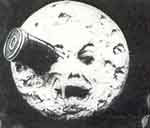 Many
early films in this genre featured similar fanciful special effects and thrilled
early audiences. The pioneering science fiction film, a 14-minute ground-breaking
masterpiece with 30 separate tableaus (scenes), Le
Voyage Dans La Lune (A Trip to the Moon) (1902), was made by imaginative,
turn-of-the-century French filmmaker/magician Georges Melies, approximating
the contents of the novels by Jules Verne (From the Earth to the Moon)
and H.G. Wells (First Men in the Moon). With innovative, illusionary
cinematic techniques (trick photography with superimposed images, dissolves
and cuts), he depicted many memorable, whimsical old-fashioned images: Many
early films in this genre featured similar fanciful special effects and thrilled
early audiences. The pioneering science fiction film, a 14-minute ground-breaking
masterpiece with 30 separate tableaus (scenes), Le
Voyage Dans La Lune (A Trip to the Moon) (1902), was made by imaginative,
turn-of-the-century French filmmaker/magician Georges Melies, approximating
the contents of the novels by Jules Verne (From the Earth to the Moon)
and H.G. Wells (First Men in the Moon). With innovative, illusionary
cinematic techniques (trick photography with superimposed images, dissolves
and cuts), he depicted many memorable, whimsical old-fashioned images:
- a modern-looking, projectile-style rocket ship blasting
off into space from a rocket-launching cannon (gunpowder powered?)
- a crash landing into the eye of the winking 'man in the
moon'
- the appearance of fantastic moon inhabitants (Selenites,
acrobats from the Folies Bergere) on the lunar surface
- a scene in the court of the moon king
- a last minute escape back to Earth
Otto Rippert's melodramatic and expressionistic Homunculus
(1916, Ger.) - mostly a lost silent film - was a serial (or mini-series)
composed of six one-hour episodic parts. It told about the life of an artificial
man (Danish actor Olaf Fonss) that was created by an archetypal mad scientist
(Friedrich Kuhne). The monstrous, vengeful creature, after realizing it was
soul-less and lacked human emotion, became a tyrannical dictator but was eventually
destroyed by a divine bolt of lightning. Its importance as an early science-fiction
film was that it served as a precursor and inspiration to Universal's Frankenstein
(1931) film and many other plots of sci-fi films (with mad scientists,
superhuman androids, Gothic elements, and the evil effects of technology).
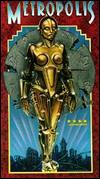 The
first science fiction feature films appeared in the 1920s after the
Great War, showing increasing doubts about the destructive effects of technology
gone mad. The first feature-length dinosaur-oriented science-fiction film to be released was The Lost World (1925). It was also the first feature length film made in the US with the pioneering first major use (primitive)
of stop-motion animation with models for its special effects. It helped to establish
its genre - 'live' and life-like giant monsters-dinosaurs, later replicated
in Gojira (1954, Jp.), Jurassic Park (1993) and Godzilla
(1998). The
first science fiction feature films appeared in the 1920s after the
Great War, showing increasing doubts about the destructive effects of technology
gone mad. The first feature-length dinosaur-oriented science-fiction film to be released was The Lost World (1925). It was also the first feature length film made in the US with the pioneering first major use (primitive)
of stop-motion animation with models for its special effects. It helped to establish
its genre - 'live' and life-like giant monsters-dinosaurs, later replicated
in Gojira (1954, Jp.), Jurassic Park (1993) and Godzilla
(1998).
One of the greatest and most innovative films ever made was a silent
film set in the year 2000, German director Fritz Lang's classic, expressionistic,
techno-fantasy masterpiece Metropolis (1927) - sometimes considered
the  Blade
Runner of its time. It featured an evil scientist/magician named Rotwang,
a socially-controlled futuristic city, a beautiful but sinister female robot
named Maria (probably the first robot in a feature film, and later providing
the inspiration for George Lucas' C3-PO in Blade
Runner of its time. It featured an evil scientist/magician named Rotwang,
a socially-controlled futuristic city, a beautiful but sinister female robot
named Maria (probably the first robot in a feature film, and later providing
the inspiration for George Lucas' C3-PO in  Star Wars), a stratified society, and an oppressed
enslaved race of underground industrial workers. Even
today, the film is acclaimed for its original, futuristic sets, mechanized
society themes and a gigantic subterranean flood - it appeared to accurately
project the nature of society in the year 2000. [It was re-released in 1984
with a stirring, hard-rock score featuring Giorgio Moroder's music and songs
by Pat Benatar and Queen.] Star Wars), a stratified society, and an oppressed
enslaved race of underground industrial workers. Even
today, the film is acclaimed for its original, futuristic sets, mechanized
society themes and a gigantic subterranean flood - it appeared to accurately
project the nature of society in the year 2000. [It was re-released in 1984
with a stirring, hard-rock score featuring Giorgio Moroder's music and songs
by Pat Benatar and Queen.]
Another Lang film, his last silent film, was one of the first
space travel films, The Woman in the Moon (1929) (aka By Rocket
to the Moon). It was about a blastoff to the moon where explorers
discovered a mountainous landscape littered with raw diamonds and chunks of
gold. [The film introduced NASA's backward count to a launch - 5-4-3-2-1 to
future real-life space shots, and the effects of centrifugal force to future
space travel films.]
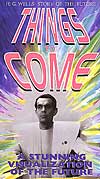 Alexander
Korda's epic view of the future Things to Come (1936) was directed
by visual imagist William Cameron Menzies and starred Raymond Massey (as pacifist
pilot John Cabal). The imaginative English film was based on an adaptation
of H. G. Wells' 1933 The Shape of Things to Come and set during the
years from 1940 to 2036 in 'Everytown.' It included a lengthy global world
war (WW II!), a prophetic Brave New World-view, a despotic tyrant named Rudolph
(Ralph Richardson), the dawn of the space age, and the attempt of social-engineering
scientists to save the world with technology. An attempt to prevent scientific
progress - and the launch of the first Moon rocket - was vainly led by sculptor
Theotocopulos (Cedric Hardwicke). David Butler's Just Imagine (1930),
a futuristic sci-fi musical about a man who awakened in a strange new world
- New York City in the 1980s, provided prophetic inventions including automatic
doors, test tube babies, and videophones. Alexander
Korda's epic view of the future Things to Come (1936) was directed
by visual imagist William Cameron Menzies and starred Raymond Massey (as pacifist
pilot John Cabal). The imaginative English film was based on an adaptation
of H. G. Wells' 1933 The Shape of Things to Come and set during the
years from 1940 to 2036 in 'Everytown.' It included a lengthy global world
war (WW II!), a prophetic Brave New World-view, a despotic tyrant named Rudolph
(Ralph Richardson), the dawn of the space age, and the attempt of social-engineering
scientists to save the world with technology. An attempt to prevent scientific
progress - and the launch of the first Moon rocket - was vainly led by sculptor
Theotocopulos (Cedric Hardwicke). David Butler's Just Imagine (1930),
a futuristic sci-fi musical about a man who awakened in a strange new world
- New York City in the 1980s, provided prophetic inventions including automatic
doors, test tube babies, and videophones.
Early Science-Fiction - Horror Film Blends: The 30s
The most memorable blending of science fiction and horror
was in Universal Studios' mad scientist-doctor/monster masterpiece from director
James Whale, Frankenstein (1931), an adaptation
of Mary Shelley's novel. Her original 1818 book was subtitled Frankenstein
- The Modern Prometheus, and she used this allusion to signify that her
main character Dr. Victor Frankenstein demonstrated 'hubris' against god/nature
in his experimental desire to create life from dead body parts, and afterwards
abandoned his monstrous ugly creature. 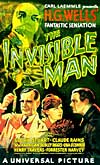 Like
the Titan god, who stole fire from the gods to benefit mankind, he did not
realize the ramifications of his actions. (Although there were civilizing
results of having fire, it also brought the ability to work with metals, which
could be shaped into weapons, that could then be used in warfare.) Many other
derivative works, including numerous sci-fi films, have featured mad scientists,
and artificially-created monsters that run amok killing people. Like
the Titan god, who stole fire from the gods to benefit mankind, he did not
realize the ramifications of his actions. (Although there were civilizing
results of having fire, it also brought the ability to work with metals, which
could be shaped into weapons, that could then be used in warfare.) Many other
derivative works, including numerous sci-fi films, have featured mad scientists,
and artificially-created monsters that run amok killing people.
This was soon followed by Whale's superior
sequel  Bride of Frankenstein (1935), one of the best examples of the horror-SF
crossover, and one of the first films with a mad scientist's creation of miniaturized
human beings. The famed director also made the film version of an H. G. Wells
novel The Invisible Man (1933) with Claude Rains (in his film debut
in the starring title role) - it was the classic tale of a scientist with
a formula for invisibility accompanied by spectacular special effects and
photographic tricks. Bride of Frankenstein (1935), one of the best examples of the horror-SF
crossover, and one of the first films with a mad scientist's creation of miniaturized
human beings. The famed director also made the film version of an H. G. Wells
novel The Invisible Man (1933) with Claude Rains (in his film debut
in the starring title role) - it was the classic tale of a scientist with
a formula for invisibility accompanied by spectacular special effects and
photographic tricks.
Mad Scientists in Early Horror/Sci-Fi Films:
In the 1930s and early 40s, American sound films with hybrid
science fiction/horror themes included an oddball collection of mad scientist
films, with memorable characters who created mutated or shrunken creatures:
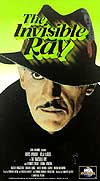 The
Vampire Bat (1932) - a low-budget Majestic Pictures film in which Lionel
Atwill starred as mad doctor Otto Von Niemann, responsible for creating
bloodsucking nocturnal bats in a small German town; with a cast including
dark-haired, 'scream-queen' Fay Wray, Melvyn Douglas, and Dwight Frye (the
crazy Renfield character in Dracula) The
Vampire Bat (1932) - a low-budget Majestic Pictures film in which Lionel
Atwill starred as mad doctor Otto Von Niemann, responsible for creating
bloodsucking nocturnal bats in a small German town; with a cast including
dark-haired, 'scream-queen' Fay Wray, Melvyn Douglas, and Dwight Frye (the
crazy Renfield character in Dracula)- Doctor X (1932), a First National (later Warner
Bros.) film, in pioneering two-strip Technicolor by director Michael Curtiz,
about another mysterious mad scientist named Doctor X-avier (Lionel Atwill)
and his daughter (Fay Wray)
- The Mystery of the Wax Museum (1933), another First
National film in two-strip Technicolor, about an insane, wax-dummy maker-sculptor,
again pairing Atwill and Wray, and featuring Glenda Farrell as a fast-talking,
wisecracking reporter; famous for the shocking 'face-mask crumbling' scene;
[re-made in 1953 as House of Wax with Vincent Price]
- The Black Cat (1934) - the
first and best of all the Karloff-Lugosi pairings at Universal, featuring
Boris Karloff (as a crazed devil worshipper) and Bela Lugosi (as a vengeful
architect)
- The Invisible Ray (1936) - although he usually played
a grotesque monster, Karloff starred as experimental physicist Dr. Janos
Rukh in this film; after traveling to Africa with his colleague Dr. Benet
(Bela Lugosi) and becoming infected by radiation (Radium X) in a meteor
of the nebula Andromeda, Karloff was transformed into a murdering, radiation-poisoned
megalomaniac as he hunted down his enemies and projected death rays at them
from his eyes (glaring from under a soft felt hat)
 Tod
Browning's off-beat The Devil Doll (1936) - with Devil's Island escapee
and scientist Paul Lavond (Lionel Barrymore), disguised as a macabre elderly
woman ("Madame Mandelip"), vengefully terrorizing his enemies
by creating shrunken "devil dolls" to seek out his revenge; with
landmark special effects, and Maureen O'Sullivan in a supporting role as
Lavond's daughter Tod
Browning's off-beat The Devil Doll (1936) - with Devil's Island escapee
and scientist Paul Lavond (Lionel Barrymore), disguised as a macabre elderly
woman ("Madame Mandelip"), vengefully terrorizing his enemies
by creating shrunken "devil dolls" to seek out his revenge; with
landmark special effects, and Maureen O'Sullivan in a supporting role as
Lavond's daughter- Ernest Schoedsack's and Paramount's Dr. Cyclops (1940) - the first Technicolor horror/sci-fi film since The Mystery of the Wax
Museum (1933), with Albert Dekker as sadistic, bald, bespectacled mad
scientist Dr. Thorkel shrinking his victims in a remote Peruvian jungle
setting; the film received an Academy Award nomination for its Visual Effects
- The Monster and the Girl (1941) - another Paramount "B" horror/sci-fi film from director Stuart
Heisler, about eccentric mad scientist Dr. Parry (George Zucco) who transplanted
the brain of a wrongly-accused and executed murderer into a murderous gorilla,
who then went on a rampage to seek revenge
- director George Sherman's The
Lady and the Monster (1944) - the first film version of the classic tale Donovan's Brain by Curt Siodmak
[remade in 1954], in which the throbbing, telepathic brain of a dead and
unscrupulous industrialist/maniac named James Donovan was kept alive by
enthusiastic mad scientist/Prof. Franz Mueller (Erich von Stroheim)
Escapist Serials of the 30s: Flash Gordon and Buck
Rogers
In the 1930s, the most popular films were the low-budget,
less-serious, space exploration tales portrayed in the popular, cliff-hanger
Saturday matinee serials with the first
two science-fiction heroes - Flash Gordon and Buck Rogers.
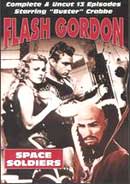 Space-explorer
hero Flash Gordon was a fanciful adventure character derived from the
Alex Raymond comic strip first published in 1934 (from King Features). The
serials 'invented' many familiar technological marvels: anti-gravity belts,
laser/ray guns, and spaceships. Universal's serialized sci-fi adventures included: Space-explorer
hero Flash Gordon was a fanciful adventure character derived from the
Alex Raymond comic strip first published in 1934 (from King Features). The
serials 'invented' many familiar technological marvels: anti-gravity belts,
laser/ray guns, and spaceships. Universal's serialized sci-fi adventures included:
- Flash Gordon: Space Soldiers (1936), the original
and the best of its type, with 13 chapters; later condensed into a 97-minute
feature film titled Flash Gordon: Rocketship
- Flash Gordon's Trip to Mars (1938) - 15 episodes
- Flash Gordon Conquers the Universe (1940), 12 episodes,
with Carol Hughes as Dale Arden
Popular elements in the swashbuckling films were the perfectly-cast,
epic hero athlete/actor Larry "Buster" Crabbe, the lovely heroine
and Flash's blonde sweetheart Dale Arden (Jean Rogers), Dr. Hans Zarkov (Frank
Shannon), and the malevolent, tyrant Emperor Ming the Merciless (Charles Middleton)
on far-off planet Mongo. The Flash Gordon films were remade in 1980
(with Sam J. Jones as the title character and Max von Sydow as Ming, with
music by Queen), and in 1997 as the animated Flash Gordon: Marooned on
Mongo. [There was also a pornographic knock-off film titled Flesh Gordon
(1972) that featured a dildo-shaped spaceship.]
Wavy-haired, muscular Buster Crabbe also starred in the
12-part serial Buck Rogers Conquers the Universe (1939) shot
between Flash
Gordon's Trip to Mars (1938) and Flash Gordon Conquers the Universe
(1940). It was derived from the novelette story "Armageddon-2419
A.D." written by Phil Nolan (published in the August 1928 issue
of the pulp magazine Amazing Stories), and from the comic
strip Buck Rogers
in the 25th Century by Dick Calkins. In this sci-fi serial, Buck
Rogers pursued the vile Killer Kane (Anthony Warde), but the series
proved to be not as popular as the Flash Gordon serials.
Another serial was Republic's 15-part serial The Purple
Monster Strikes (1945), aka D-Day on Mars, with one of
the first instances of alien invasion. And in Columbia's 15-episode
serial Bruce
Gentry - Daredevil of the Skies (1949), the hero (Tom Neal) fought
off the genre's first flying saucers. |
